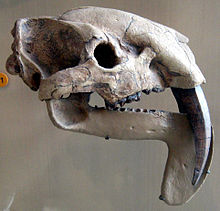Thylacosmilus
|
Thylacosmilus Temporal range: late Miocene–late Pliocene |
|
|---|---|
 |
|
| skull cast: Original is P 14531 in the collections of the Field Museum of Natural History | |
| Scientific classification | |
| Kingdom: | Animalia |
| Phylum: | Chordata |
| Class: | Mammalia |
| Infraclass: | Metatheria |
| Order: | †Sparassodonta |
| Family: | †Thylacosmilidae |
| Genus: |
†Thylacosmilus Riggs, 1933 |
| Species: | T. atrox |
| Binomial name | |
|
Thylacosmilus atrox Riggs, 1933 |
|
| Synonyms | |
|
|
Thylacosmilus atrox is an extinct species of saber-toothed metatherian that inhabited South America from the late Miocene to Piacenzian epochs. Remains of this animal have been found primarily in Catamarca, Entre Ríos, and La Pampa Provinces in northern Argentina.
Though Thylacosmilus is one of several predatory mammal genera typically called "saber-toothed cats", it was not a felid but a sparassodont, a group closely related to marsupials, and only superficially resembled other saber-toothed mammals due to convergent evolution.
Thylacosmilus had large, saber-like canines. The roots of these canines grew throughout the animal’s life, growing in an arc up the maxilla and above the orbits. Its cervical vertebrae were very strong and to some extent resembled the vertebrae of Machairodontinae. Recent comparative biomechanical analysis have estimated the bite force of T. atrox starting at maximum gape at 38 newtons (8.5 lbf), much weaker than that of a leopard, suggesting its jaw muscles had an insignificant role in the dispatch of prey. Its skull was similar to that of Smilodon in that it was much better adapted to withstand loads applied by the neck musculature, which, along with evidence for powerful and flexible forelimb musculature and other skeleton adaptations for stability, support the hypothesis that its killing method consisted on immobilization of its prey followed by precisely directed, deep bites into the soft tissue driven by powerful neck muscles.
Body mass estimates of Thylacosmilus suggest this animal weighed between 80–120 kilograms (180–260 lb), and one estimate suggesting up to 150 kg (330 lb), about the same size as a modern jaguar. This would make it one of the largest known carnivorous metatherians.
...
Wikipedia
